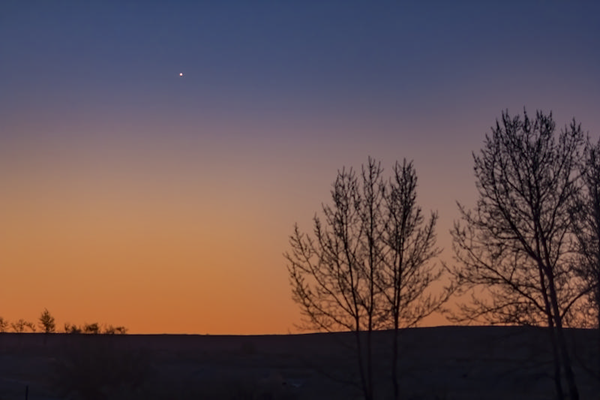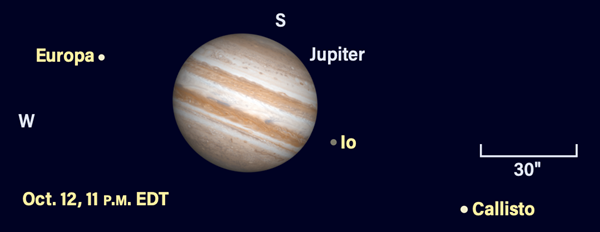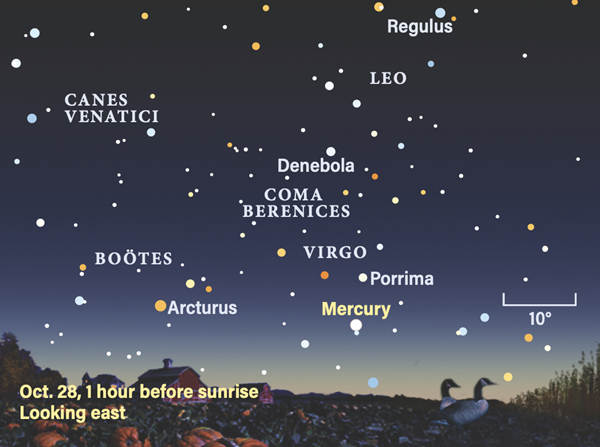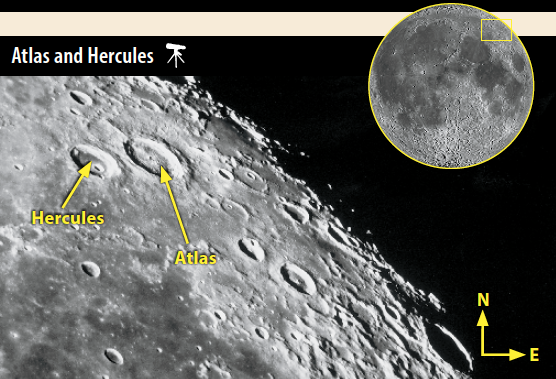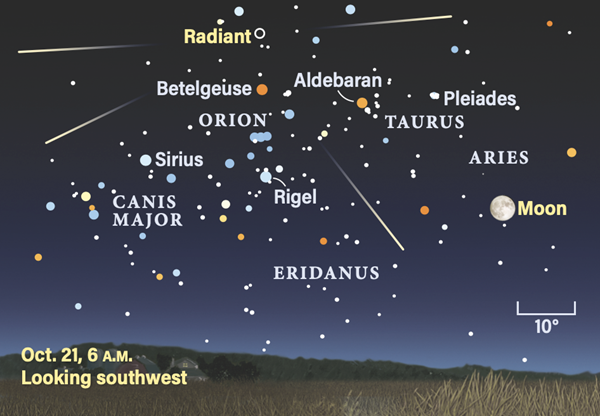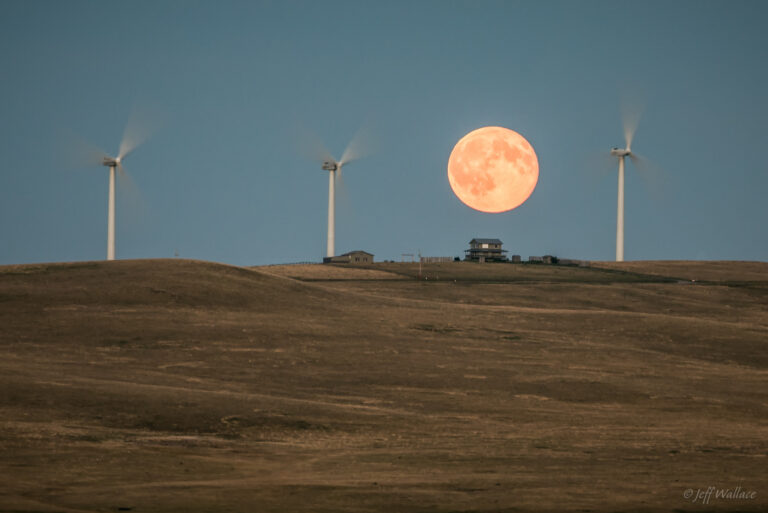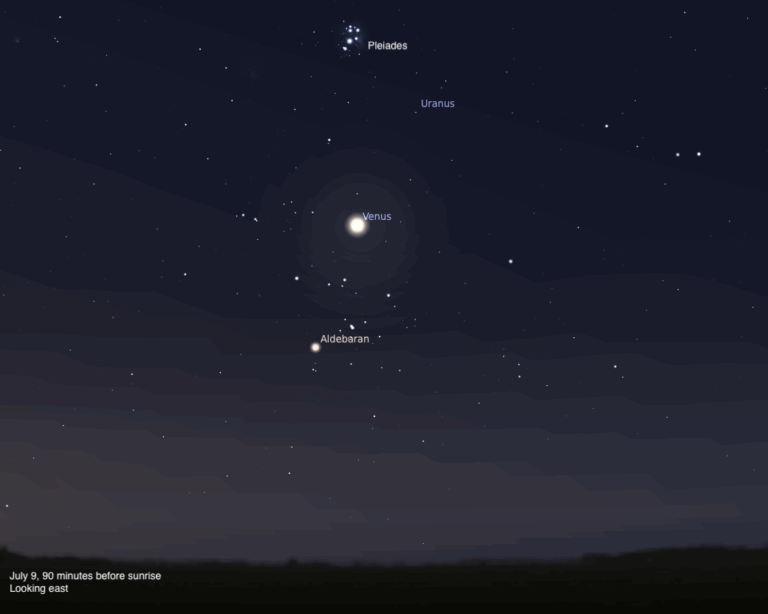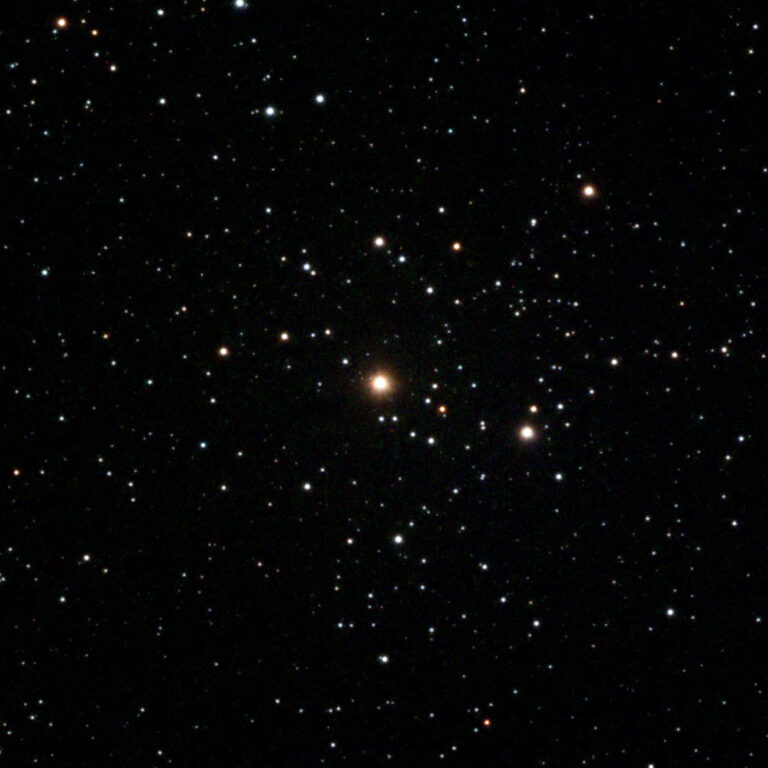Key Takeaways:
Mercury springs into action in the last two weeks of October, offering its best morning appearance for 2021. Venus, by contrast, hangs low in the southwestern sky all month. Jupiter and Saturn dominate the evening sky, visible through midnight. And late-evening binocular views of Uranus and Neptune beckon more adventurous observers.
Let’s begin in the evening sky. Venus is visible soon after sunset, low in the southwest. It begins the month at magnitude –4.2 and brightens to –4.5 by Oct. 25. The planet lies in Libra for the first week of October and crosses into Scorpius Oct. 7. Venus spends part of Oct. 15 crossing a small corner of Ophiuchus, before returning to Scorpius and passing 1.5° north of Antares on the 16th. It returns to Ophiuchus Oct. 21 and stays there through the end of the month.
Venus reaches its greatest elongation east of the Sun Oct. 29, when it stands 47° from our star. However, this does little to increase the planet’s altitude after sunset, due to the low angle of the ecliptic to the western horizon. An hour after sunset, Venus is always between 7° and 11° high.
Any telescope reveals its changing appearance. On Oct. 1, the planet subtends 19″ and is 62 percent lit. The disk grows to 24″ by Oct. 27 and reveals a lovely half-illuminated phase. By Halloween, the disk spans 26″ and is less than 50 percent lit.
One observational curiosity is the moment the phase reaches exactly 50 percent. Venus’ observed phase often differs from the calculated phase. Called Schröter’s effect, the onset of dichotomy might be observed up to a week before Oct. 27. The likely culprits at the heart of this effect are the dimness of the central part of the terminator combined with the scattering of light in the venusian atmosphere. When do you observe Venus as 50 percent lit?
As soon as the sky is dark, look low in the south for two bright objects. The westernmost is Saturn, followed by Jupiter 16° farther east. Both are in Capricornus the Sea Goat.
Saturn’s motion against the background stars grinds to a halt as its retrograde path ends Oct. 10 and it resumes eastward motion. The planet’s movement is barely noticeable by eye. Saturn shines at magnitude 0.4 in early October and dims by 0.1 magnitude in the latter half of the month. On Oct. 13, Saturn stands about 6° northeast of a waxing gibbous Moon.
The giant is a stunning sight in a telescope, with the best viewing in the few hours after sunset. The magnificent ring system, tilted by 19° to our line of sight, is clearly on view around the 17″-wide planetary disk. The northern face of the ring system is now visible. Over the next few years, the rings will become narrower, revealing more of the planet’s southern hemisphere. The brightest ring is Ring B, separated from the duskier Ring A by the Cassini division. Ring C, or the Crepe ring, is quite thin. You should be able to see the planet through it.
Saturn’s yellowish disk reveals few details. Rare storms do pop up, so watch for small white spots that might develop into something larger. An equatorial belt is often visible under good seeing conditions.
The brightest moon of Saturn, magnitude 8.5 Titan, is easy to see through any telescope. It appears north of the planet Oct. 5 and 21, and south of the planet Oct. 13 and 29.
A trio of 10th-magnitude moons orbit closer than Titan. Tethys, Dione, and Rhea are quite easy to spot. More difficult is Enceladus, shining near magnitude 12. It lies close to the bright edge of the rings.
Iapetus reaches superior conjunction Oct. 10, then progresses east, reaching greatest elongation Oct. 29. Its darker face has turned earthward, dimming it to 12th magnitude. It stands 8′ east of Saturn, 12 times farther than Tethys, also east of the rings the same night.
Saturn sets about 2 A.M. local time on Oct. 1 and just before midnight by Halloween.
Jupiter shines brilliantly in eastern Capricornus all month, dimming slightly from magnitude –2.6 to –2.5. Its retrograde path slows to a halt Oct. 18, a week after Saturn. Attentive skywatchers will see Jupiter’s position relative to Deneb Algedi change slightly this month. It lies 1.8° northwest of the star Oct. 1 and moves to a point 2.1° northwest by Oct. 18. It then returns to within 1.9° of Deneb Algedi by Oct. 31. On Oct. 14 and 15, the waxing gibbous Moon lies nearby. The planet sets about 3:10 A.M. local time on Oct. 1, and by 1:15 A.M. on Oct. 31.
Jupiter is best viewed beginning in late twilight — when low-contrast views of its atmosphere are a sight to behold — and for a few hours into the evening, before it sets in the west after midnight. Any telescope reveals wonderful detail, from the planet’s pair of dark equatorial belts to more subtle features to their north and south. Every few days, the Great Red Spot is also visible.
Observers can also catch the four Galilean moons. Their resonant orbits mean some events repeat during the month. For example, at 9:48 P.M. EDT on Oct. 5, Io comes out of eclipse by Jupiter’s shadow, which stretches east of the planet. Europa is occulted by Jupiter’s western limb 26 minutes later, at 10:14 P.M. EDT.
These events repeat Oct. 12/13, with a nice addition: Before Io comes out of eclipse, Callisto enters eclipse from an unusual location — farther from Jupiter than Io’s position at reappearance. The reason is that at Callisto’s greater distance from Jupiter, the planet’s shadow extends farther east. Callisto begins to disappear at 11:11 P.M. EDT, followed by Io’s reappearance at 11:43 P.M. EDT. Such events highlight the geometry of the jovian system. An hour later, at 12:40 A.M. EDT on the 13th, Europa dips behind Jupiter’s western limb.
The Io/Europa pair performs a similar act early on Oct. 20. On Oct. 28, Io reappears from eclipse 6″ northwest of Europa, just minutes after 10 P.M. EDT.
Neptune is a month past opposition and visible most of the night in Aquarius the Water-bearer. Binoculars will show the magnitude 7.7 planet well. Neptune begins the evening in the southeastern sky and reaches its highest point above the southern horizon before local midnight.
October opens with Neptune less than 4° east of magnitude 4 Phi (ϕ) Aquarii. The gap shrinks to 3.3° by Oct. 31. Look roughly 6.5° south of the Circlet in Pisces for a triangle of 6th-magnitude field stars; Neptune is west of this group all month. You can also use a pair of 6th-magnitude stars east of Phi in same binocular field of view. Draw a line from Phi through the midpoint of a line connecting these stars, and you’re heading right for Neptune. The ice giant stands 7° west of a gibbous Moon Oct. 17.
Neptune currently spans 2″. A telescope at high magnification on a steady night of seeing will show its bluish-green disk.
Uranus is approaching opposition, which occurs next month, and is visible nearly all night. In early October, wait a few hours after sunset to view it. Uranus lies about 16° west of the Pleiades, in a sparse region of southern Aries. It should be easy to spot at magnitude 5.7, especially with a handy nearby star to guide you. Uranus begins the month close to Omicron (ο) Arietis, which shares the planet’s current magnitude. On Oct. 1, they are 23′ apart. By Oct. 10, Uranus is less than 10′ to the star’s north. Uranus continues westward and lies a Full Moon’s width west of Omicron by Oct. 24.
Omicron is 2.9° due north of 38 Arietis, which itself is 2.3° due north of 4th-magnitude Mu (μ) Ceti. Look for Mu in 7×50 binoculars before midnight and place it in the lower right of your field of view. 38 Arietis should be near the center of the field of view. If you’re looking around midnight, instead place Mu at the bottom of your field of view. From Mu, move your binoculars to place 38 Arietis in the lower right and look for a 6th-magnitude double star — one of those “stars” is Uranus. Check each night and you’ll easily spot the planet’s motion.
Mercury reaches inferior conjunction with the Sun Oct. 9. You might imagine it will next cross in front of the Sun, but not this month. Such transits only occur when inferior conjunction is in May or November, when the planet’s orbit crosses the ecliptic. Nov. 13, 2032, is the next time this happens.
Mercury skips into the morning sky soon after conjunction and is well placed before sunrise. The high angle of the ecliptic at dawn makes this the planet’s best morning apparition for Northern Hemisphere observers this year. Mercury reaches greatest elongation (18°) Oct. 25. This is far shy of the possible 27°, due to the fact that Mercury reached perihelion just a week earlier, on the 19th. Observers with a clear eastern horizon might catch Mercury that day, shining at magnitude 0.4 and only 3.5° high an hour before sunrise.
Two days later, Mercury is much easier to spot. By Oct. 21, it’s magnitude 0 and nearly 5° high an hour before sunrise. A week later, on Oct. 28, it has brightened to magnitude –0.7, an easy object with the unaided eye. Mercury brightens by another 0.1 magnitude through the end of the month and remains clearly in view each morning, even as its elongation from the Sun slowly diminishes.
Mars is too close to the Sun to observe this month. It returns to the morning sky by December.
Rising Moon: Splish splash
A day before First Quarter, the Moon shows us a face of thirds. The south is a crowded, cratered mess that quickly morphs into the equatorial slate gray seas, whose large frozen waves are known as wrinkle ridges. Venture up to the northern third, where the smoothness is punctuated by a handful of large identifiable craters.
On Oct. 11, the ramparts of Aristoteles lie aglow in the rising Sun, mostly emerged from the terminator. One Earth day later, we can see this marvelous, complex crater fully lit. Craters half its 50-mile size boast cleaner lines and a simpler peak, but Aristoteles’ features suffered much more during the greater energy release of a larger impact. In moments of good seeing, there is a lot of structure to see here.
Splattering back down after the blast, the vast amount of excavated soil spreads a large apron around Aristoteles, creating an uncountable number of small secondary craters. You can only see them flit in and out of view in the slanted light near lunar sunrise or sunset. By the 13th, the higher lunar Sun has erased these shadowlets from view. The inner crater walls, weakened from the impact, have slumped into a series of terraces. Millions of years later, lava welled up from underneath, flooding the inside — but not quite enough to cover the peaks at the center.
Return for a look around Full Moon and pop in a filter to cut down on the glare. Sweeping in a gentle arc of dark gray across the lunar north is Mare Frigoris. Aristoteles has been transformed to an oval of light material, paired with the smaller, more circular crater Eudoxus just to the south. What a change solar noon brings!
Meteor Watch: Full Moon interference
This month’s Full Moon falls within a day of the Oct. 21 peak of the Orionid meteor shower. Moonlight will effectively diminish the visibility of all shower meteors except for the brightest ones, so observed rates will be very low this year. The Orionid shower is directly linked to debris left over by the regular 76-year passages Halley’s Comet.
The shower is active from Oct. 2 through Nov. 7, with much lower rates outside the night of maximum. A few Orionid meteors can be observed in the early morning sky the week before Full Moon — the best opportunity for spotting Orionids this year. For example, on Oct. 13, the First Quarter Moon sets around midnight, as Orion is rising. The dark sky will offer views of early shower members, but at much lower rates than the peak of 20 meteors per hour at maximum.
Comet Search: Crossing the plane
We have a multitude of 10th- to 11th-magnitude comets to choose from this month. The least erratic is 67P/Churyumov-Gerasimenko. Approaching as close to us as Mars, it receives a modest cooking from the Sun’s rays, pouring out dust in a reasonably reliable way.
After midnight, find it following Aldebaran up the northeastern sky. On Oct. 8, it skims only 1° north of the Crab Nebula (M1). And your reward for waiting until moonset before dawn on the 16th is the comet posing with the splashy star cluster M35 in Gemini.
This snowball’s soft glow will need a 4-inch scope under dark skies. An 8-inch aperture reveals the well-defined bow shock on the eastern flank, where the solar wind pushes back the dust. At month’s end, Earth passes through the plane of the comet’s orbit, giving us an edge-on view and a good chance at seeing a weak anti-tail, where the dust and ion stream poke out the other side.
Also don’t miss 4P/Faye, cruising 8° to the south. It too gives us a plane crossing (on the 6th). About the same distance to Churyumov-Gerasimenko’s northeast, perhaps C/2019 L3 (ATLAS) will be acting up. Meanwhile, 6P/d’Arrest swipes past globular cluster M55 in Sagittarius midmonth, but this small comet will be a pale fuzz in comparison.
Locating Asteroids: The tortoise and the hares
The second asteroid to be discovered, 2 Pallas happens to orbit on one of the most inclined paths of the main-belt family. Currently it is diving south through the ecliptic, the nearly flat racetrack of our solar system.
A 4-inch scope will let you track 9th-magnitude Pallas through the waters of Aquarius. Start at Saturn, pass straight through Jupiter for about the same distance, and you’ll land on magnitude 3.7 Lambda (λ) Aquarii. Then scooch over a degree or two. The telltale sign of an asteroid is its night-to-night movement. For visual observers, the displacement is not enough to notice in a single session. Make a sketch of the starfield indicated by the chart and come back in another night or two to see which dot has shifted.
While you’re gazing intently in the eyepiece, expect to be distracted by a slowly moving “star” that takes about four minutes to cross a 1°-wide field. We happen to be looking through the belt of geostationary satellites girdling our planet. The farther north you live, the farther south they appear to track on the sky. You might see half a dozen in a matter of 20 minutes.

